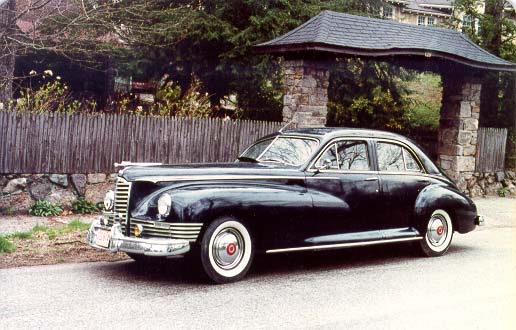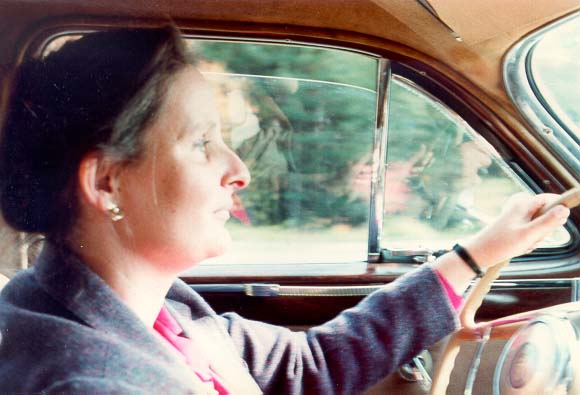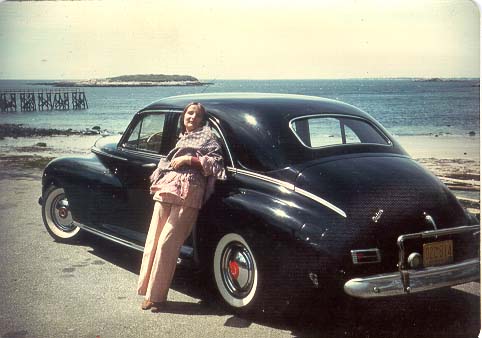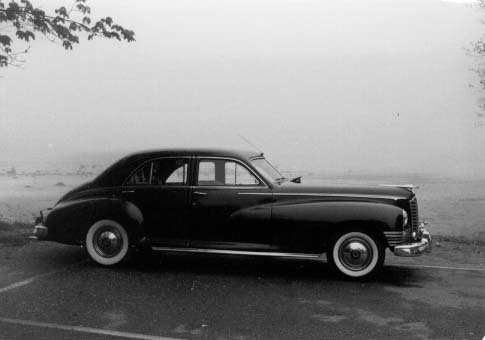![]()
The story of my 1947 Packard Custom 8 Sedan is really a story about life with my wife, whom I met in 1976 when I only owned the Morgan and Mercedes. She is a recital and concert/opera mezzo soprano, so my expanding life was not well served by the sport cars. I set out to find a suitable carriage, which must be larger, more formal, and accomodate 5 passengers, because after concerts we would often drive other musicians home (musicians often cannot afford a car).

I was attracted to the Packards largely because of the luxurious feeling of their leather, wool, and wood interiors and stylish appointments. I really expected to find a 1948-50 model, but surprisingly found the rarer 1947 model. This car has all the best options, inclusing the straight-8 356 cu. in. engine and overdrive for silky smooth operation. It is so quiet that at times people at gas stations don't even notice that it is running.

We took this car to New York when my wife, Jane Struss, sang "Oh Roeschen rot" in the Mahler 2'nd symphony at Carnegie hall, and by chance I snapped the picture of her driving the car. The attendant at the parking lot by the Carnegie hall stage door gave us the most prominent place by the sidewalk, and we all felt very elegant. Dinner afterwards at a fashionable restaurant was followed by Jane receiving congratulatory phone calls.

The story of the Packard Clipper relates to automotive development at the end of the depression era 1930's decade. The American population was tired of the era and looking toward a new decade to bring new life. The major auto manufacturers wanted to introduce radical modern designs, but were mindful of the Chrysler Airflow disaster of the 30's, where Chrysler introduced a design so modern that it failed and almost destroyed the company. So Cadillac introduced the 60 Special, Lincoln introduced the Continental, and Packard introduced the Clipper as new models with forward thinking, but all continued to produce the more traditional designs in case the modern cars failed. Thus in 1941 and 1942 you could purchase the Packard Clipper or the more traditional car, like my 1942 160.

I believe you would have to say that the Packard was the most successful of the new designs, since its essentially different fenders blended smoothly into the doors and were copied by the industry and appeared on all Chrysler Corporation products (including DeSoto, Dodge, and Plymouth) immediately after the war. The Cadillac 60 Special and Lincoln Continental still had the chunky front fenders that ended abruptly just before the front door.
Packard never realized the boost that their succesful design should have given them, because by the end of the war their design was no longer fresh. In the immediate postwar period, Packard produced only Clipper models, having sent tooling for the big square cars to Russia as part of Lend Lease. And postwar production was concerned with logistical problems of obtaining sufficient rubber and steel to produce automobiles again, so no convertible model of the clipper was ever developed. The Clipper style was replaced in the 1948 model year.
I find the styling advance from the 1942 boxy style to the Clipper to be astonishing. Long straight lines from front to rear suggest smooth airflow and offer prospects for silky-smooth passage. The rear tapers gracefully back to earth, but the old graceful curve at the rear of the top is still incorporated in the sheet metal. Many people are impressed by the grace and beauty of this automobile, and I am privilidged to own it.
[ Main ]